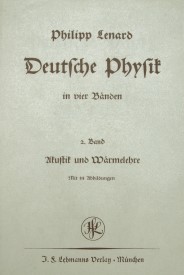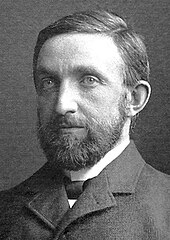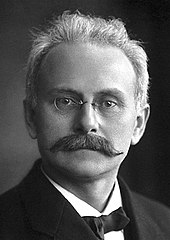Deutsche Physik

Deutsche Physik (German:
Deutsche Physik was opposed to the work of Albert Einstein and other modern theoretically based physics, which was disparagingly labeled "Jewish physics" (German: Jüdische Physik).
Origins

This movement began as an extension of a
After the war, the perceived affronts of the
During the early years of the twentieth century,
Under the Third Reich

When the Nazis entered the political scene, Lenard quickly attempted to ally himself with them, joining the party at an early stage. With another Nobel laureate in Physics, Johannes Stark, Lenard began a core campaign to label Einstein's relativity as Jewish physics.
Lenard[11] and Stark benefited considerably from this Nazi support. Under the rallying cry that physics should be more "German" and "Aryan", Lenard and Stark embarked on a Nazi-endorsed plan to replace physicists at German universities with "Aryan physicists". By 1935, though, this campaign was superseded by the Nuremberg Laws of 1935. There were no longer any Jewish physics professors in Germany, since under the Nuremberg Laws, Jews were not allowed to work in universities. Stark in particular also tried to install himself as the national authority on "German" physics under the principle of Gleichschaltung (literally, "coordination") applied to other professional disciplines. Under this Nazi-era paradigm, academic disciplines and professional fields followed a strictly linear hierarchy created along ideological lines.
The figureheads of "Aryan physics" met with moderate success, but the support from the Nazi Party was not as great as Lenard and Stark would have preferred. They began to fall from influence after a long period of harassment of
Lenard began to play less and less of a role, and soon Stark ran into even more difficulty, as other scientists and industrialists known for being exceptionally "Aryan" came to the defense of relativity and quantum mechanics. As historian Mark Walker puts it:[citation needed]
... despite his best efforts, in the end his science was not accepted, supported, or used by the Third Reich. Stark spent a great deal of his time during the Third Reich fighting with bureaucrats within the Nazi state. Most of the Nazi leadership either never supported Lenard and Stark, or abandoned them in the course of the Third Reich.
Effect on the German nuclear program
It is occasionally put forth
See also
- Ahnenerbe (Nazi archaeology)
- Criticism of the theory of relativity
- Deutsche Mathematik
- Japhetic theory
- Lysenkoism
- Politicization of science
- Suppressed research in the Soviet Union
- Wilhelm Müller (physicist)
References
- ISBN 9781846140136.
- ^ Gibson, Craig (30 January 2008). "The culture of destruction in the First World War". Times Literary Supplement. Retrieved 18 February 2008.
- ^ LOST MEMORY – LIBRARIES AND ARCHIVES DESTROYED IN THE TWENTIETH CENTURY ( Archived 5 September 2012 at the Wayback Machine)
- ^ Theodore Wesley Koch. The University of Louvain and its library. J.M. Dent and Sons, London and Toronto, 1917. Pages 21–23. "Archived copy" (PDF). Archived from the original (PDF) on 7 May 2014. Retrieved 17 September 2012.
{{cite web}}: CS1 maint: archived copy as title (link) accessed 18 June 2013 - J. L. Heilbron, ed.), Oxford University Press, New York 2003, p. 419.
- ^ Stephan L. Wolff: Physiker im Krieg der Geister, Zentrum für Wissenschafts- und Technikgeschichte, München 2001, "Archived copy" (PDF). Archived from the original (PDF) on 10 June 2007. Retrieved 2 August 2007.
{{cite web}}: CS1 maint: archived copy as title (link). - ^ Philipp Lenard, England und Deutschland zur Zeit des großen Krieges – Geschrieben Mitte August 1914, publiziert im Winter 1914, Heidelberg.
- ^ Heinz Eisgruber: Völkische und deutsch-nationale Führer, 1925.
- ^ Der Fall Philipp Lenard – Mensch und "Politiker", Physikalische Blätter 23, No. 6, 262–267 (1967).
- ^ "The Nobel Prize in Physics 1905". Nobel Foundation. Archived from the original on 8 October 2008. Retrieved 9 October 2008.
- ^ Philipp Lenard: Ideelle Kontinentalsperre, München 1940.
- ^ Padfield, Peter (1990), Himmler, New York: Henry Holt.
- ^ Einstein: His Life and Universe. Chapter 21: The Bomb
- ^ German Nuclear Weapons
- ^ Jeremy Bernstein, Hitler's Uranium Club, the Secret Recordings at Farm Hall, 2001, Springer-Verlag
Further literature
- Ball, Philip, Serving the Reich: The Struggle for the Soul of Physics Under Hitler (University of Chicago Press, 2014).
- Beyerchen, Alan, Scientists under Hitler: Politics and the physics community in the Third Reich (New Haven, CT: Yale University Press, 1977).
- Hentschel, Klaus, ed. Physics and National Socialism: An anthology of primary sources (Basel: Birkhaeuser, 1996).
- Philipp Lenard: Wissenschaftliche Abhandlungen Band IV. Herausgegeben und kritisch kommentiert von Charlotte Schönbeck. [Posthumously, German Language.] Berlin: GNT-Verlag, 2003.
- Walker, Mark, Nazi science: Myth, truth, and the German atomic bomb (New York: HarperCollins, 1995).
External links
 Works related to The Bad Nauheim Debate at Wikisource
Works related to The Bad Nauheim Debate at Wikisource
